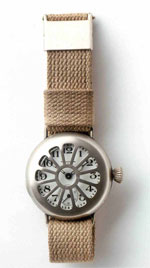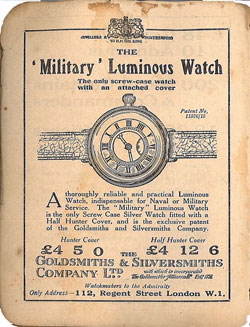
2014 marks the 100th anniversary of the outbreak of World War 1. In today’s blog post, we look at how wrist watches became essential pieces of equipment for officers in the trenches and the subsequent shift to fashion accessory after the war ended.
The “wrist-let” was a type of watch that was used by the military during World War I because traditional pocket watches were not practical for use in combat. Although originally viewed as a woman’s accessory, the wrist-let evolved into a timepiece called the Trench Watch, which was one of the first designs incorporating features from both pocket watches and wrist watches.
Many famous companies, such us Omega and Longines, produced wrist watches for the military. They tended to have an enamel dial, white numerals, a luminescent hour hand and hinged front and back covers. As they freed up both hands for the wearer, they were an invaluable piece of equipment for the combat soldier, accurately timing military operations and ideal for planning synchronised strategies.
The new bracelet design was expandable and flexible – perfect for adapting to each individual wearer regardless of their role and nature of their environment. Metal grills were made and fitted to the glass crystal watch faces to act as shields against damage from shrapnel and shock-waves during a bombardment.
Some men used leather covers to protect both the glass and mechanism of the watches but these proved a little cumbersome during a time of high alert and constant military preparedness.
Most German troops were issued with the older-style “pocket watch” designs but Allied forces could choose from a variety of brand new models. Leather straps, radium-illuminated dials and protection against damage from shock were common features of the wristwatches being issued to the Allies.
Considered a wartime necessity, the wristwatch also became a popular accessory for both men and women in general society, to the extent that many watchmakers struggled to keep up with demand after World War I ended in 1918.
DID YOU KNOW?
- The name “wrist-let” was used until early 1930s and was eventually replaced by the modern name “wrist watch”.
- It’s believed that Girard-Perregaux equipped the German Imperial Naval with similar wristwatches as early as the 1880s!

